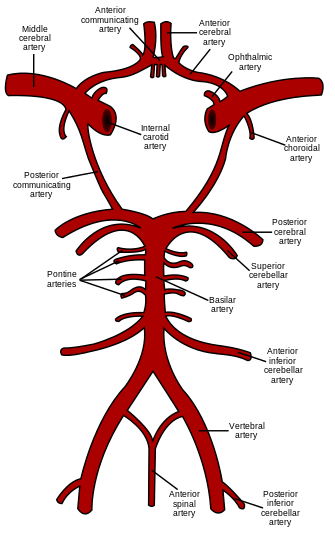Artery of Percheron
| Artery of Percheron | |
|---|---|
 The arterial circle and arteries of the brain. The artery of Percheron (not shown) arise from either the left or right posterior cerebral artery (bottom forks) | |
| Details | |
| Source | Posterior cerebral artery |
| Supplies | Both sides of thalamus and midbrain |
The artery of Percheron (AOP) is a rare anatomic variation in the brain vascularization in which a single arterial trunk arises from the posterior cerebral artery (PCA) to supply both sides of brain structures; the thalamus and midbrain.
Clinical significance
The functions of the thalamus and midbrain include the regulation of consciousness, sleep and alertness. Occlusion of the artery of Percheron, for example by a clot, could result in a posterior circulation infarct impairing structures on both sides of the brain. This can produce a bizarre disturbance such as sleep from which the patient cannot be awakened.[1]
History
The artery of Percheron was first described in 1973 by the French medical scientist Gerard Percheron.[2][3]
References
- ↑ Sanders, Lisa (February 3, 2012). "Think Like a Doctor: Sleeping Wife Solved!". The New York Times.
- ↑ Percheron G (August 1973). "The anatomy of the arterial supply of the human thalamus and its use for the interpretation of the thalamic vascular pathology". Zeitschrift für Neurologie. 205 (1): 1–13. doi:10.1007/BF00315956. PMID 4126735.
- ↑ Agarwal N, Chaudhari A, Hansberry DR, Prestigiacomo CJ (January 2014). "Redefining thalamic vascularization vicariously through gerald percheron: a historical vignette". World Neurosurgery. 81 (1): 198–201. doi:10.1016/j.wneu.2013.01.030. PMID 23314026.
This article is issued from Wikipedia - version of the 6/7/2016. The text is available under the Creative Commons Attribution/Share Alike but additional terms may apply for the media files.